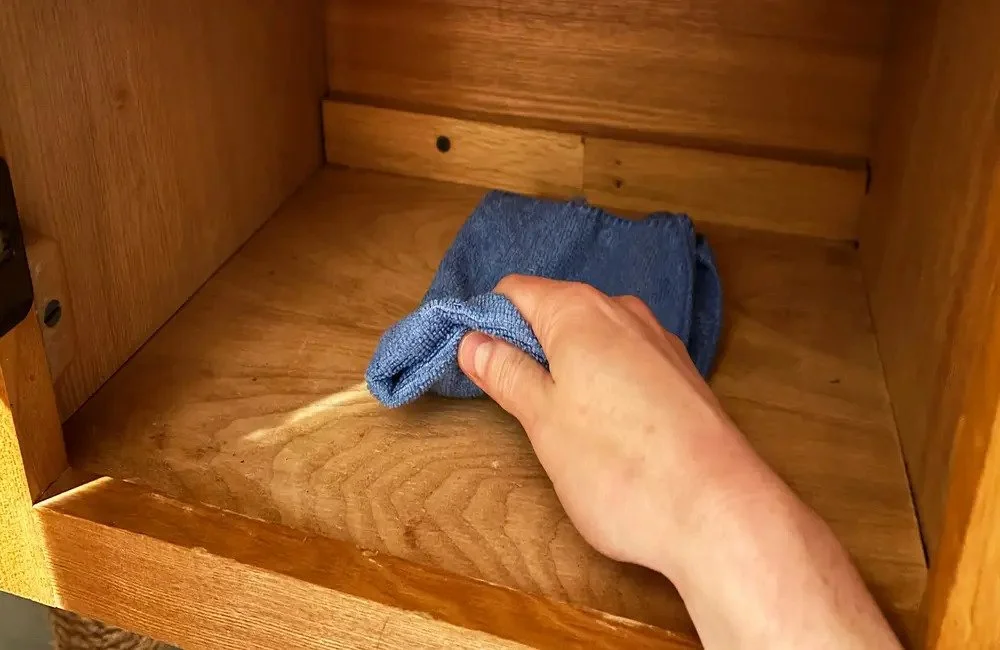How to Clean Kitchen Cabinet Doors? Step-by-Step Guide
Let’s be honest, kitchen cabinets collect it all—grease, fingerprints, and splashes from cooking mishaps. Nothing escapes them for long.
Ignoring them makes your entire kitchen look worn out and unkempt.
The good news? Cleaning them is simple. You don’t need expensive products or endless scrubbing—just the right approach.
ways to refresh your cabinet doors. If you're looking to go beyond a basic refresh, consider custom built-ins for smart storage in Miami to maximize space and elevate your home's functionality.
Ready? Let’s make it happen.
How to clean kitchen cabinet doors?
Use mild dish soap and warm water with a soft cloth. Wipe gently, clean edges and handles, and dry right after to avoid damage.
Key Takeaways
Kitchen cabinet doors collect grease, dust, and stains fast.
Regular cleaning keeps them fresh and prevents damage.
Use mild soap, warm water, and soft cloths.
Tackle edges, handles, and tough stains carefully.
Avoid harsh chemicals and always dry after cleaning.
Why Cleaning Kitchen Cabinet Doors Matters
Grime builds up fast. Grease, dust, and fingerprints quickly turn doors into magnets for dirt if left unchecked.
Dirty doors ruin the look. No matter how stylish your kitchen, grimy cabinets bring it down. Clean doors instantly lift the space.
Built-up dirt does more than look bad. Over time, it wears down finishes and stains surfaces. Regular cleaning helps them last longer.
It’s about hygiene too. You prepare food here, and sticky doors collect bacteria. Regular cleaning keeps your space safer and cleaner.
What You’ll Need Before You Start
Forget fancy cleaners. Mild dish soap mixed with warm water handles daily grime. For stubborn grease, a little vinegar works wonders.
Gather your tools. Microfiber cloths wipe without scratching and avoid streaks. A soft sponge or old toothbrush easily tackles corners and grooves.
Finally, keep dry towels handy. Wet doors can leave spots or cause damage. Wipe them dry for the best results.
Step-by-Step Guide to Cleaning Cabinet Doors
Step 1: Dust first
Skip the mess. Use a dry microfiber cloth to wipe away loose dust and dirt.
Step 2: Pick the right cleaner
Mild dish soap is your go-to. For wood doors, stick with gentle cleaners. No harsh stuff.
Step 3: Wipe down carefully
Dampen your cloth lightly. Wipe with smooth motions. Avoid soaking the doors, especially wood.
Step 4: Hit the edges and handles
Grease hides here. Use a soft brush or old toothbrush to clean tight spots.
Step 5: Dry immediately
Prevent water stains by drying immediately after cleaning. This keeps doors looking sharp.
Tips for Tough Stains and Grease Build-up
1. Grease Got You? Try This First
Grease loves cabinet doors. It clings stubbornly and doesn’t go away easily.
Mix warm water with dish soap and wipe gently. The grease should come off easily. Still sticky? Try white vinegar. Dab and wipe until clean.
Baking Soda for Stubborn Spots
Some stains are tougher. No worries. Make a paste with baking soda and water. Rub softly using a cloth. Stains fade without scratching.
Don't Go Nuclear
Avoid harsh cleaners like bleach or strong chemicals. They can damage cabinet finishes. Stick with gentle cleaners. They get the job done, minus the drama.
How Often Should You Clean Kitchen Cabinet Doors?
Quick Wipe: Weekly
Life happens fast. So does dirt. Wipe your cabinet doors weekly to keep dust, grease, and fingerprints from stacking up. A quick swipe with a damp cloth does the trick.
Deep Clean: Every Few Months
Every few months, give your cabinets a deeper clean. Think of it as a reset. Grab a gentle cleaner and tackle built-up grime, especially near handles and edges.
Spot Check: As Needed
Sticky splatter? Handle it right away. The sooner you clean a mess, the easier it is. No one likes scrubbing dried pasta sauce later.
Mistakes to Avoid When Cleaning Cabinet Doors
Scrubbing Like It’s a Gym Workout
Going too hard doesn’t mean cleaner. It means scratches. Use a soft touch and let the cleaner do the heavy lifting.
Using Harsh Cleaners
Bleach and ammonia? Big no. They wreck finishes fast. Stick with gentle solutions made for your cabinet’s material.
Skipping the Drying Step
Leaving water on the surface? Not smart. Moisture sneaks in and warps wood. Always finish with a clean, dry cloth.
Ignoring Hinges and Edges
These spots collect grime too. Give them a quick wipe or dirt will build up and ruin the whole look.
Frequently Asked Questions
1. How often should I clean kitchen cabinet doors?
Once a week keeps them looking sharp. Grease and grime build fast, so stay ahead of it.
2. What’s the safest cleaner for cabinet doors?
Warm water and mild dish soap. Skip harsh stuff that can wreck the finish.
3. Can I use vinegar to clean cabinet doors?
Yes, for grease and light stains. Avoid frequent use on real wood, as vinegar can be too harsh.
4. What if the stains won’t come off?
Try baking soda paste. Still stuck? A soft toothbrush is your secret weapon.
5. Should I clean handles and edges too?
Absolutely. That’s where grime loves to hide. Quick wipe, easy win.
Conclusion
Keep your cabinets clean and your kitchen looking great.
Messy cabinet doors ruin the look. A quick wipe keeps your space looking sharp and ready for guests or lazy pizza nights.
It’s simple. Use the right cleaner, stay gentle, and don’t forget the handles.
Consistency is key. Tackle grime often and you’ll avoid heavy-duty scrubbing later.
Your kitchen’s style starts small. Clean doors offer an instant upgrade without spending much.
So grab that cloth. Make your cabinets shine. Trust me, your future self (and your next dinner guest) will thank you.


